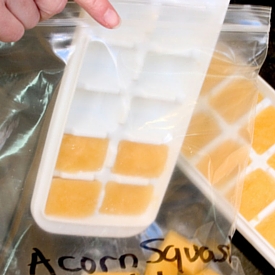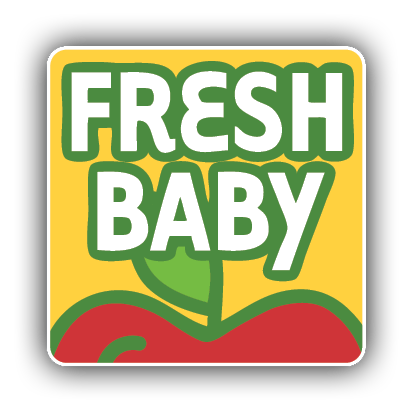
Making baby food is healthier for your baby, and offers your baby an introduction to foods rich in variety, flavor, color, taste and smell. All of your friends, and your mother-in-law, will think you are a super parent for making your baby’s food. The big secret – it is super easy and takes less them 30 minutes per week.
A common approach to making baby food is called the “ice cube tray” method. The concept is simple: make large quantities of basic food purees using a standard blender or food processor and freeze it in single servings (one ounce) in ice cube trays. With this method, you only need to make baby food once, maybe twice, per week. Over time you build up a large variety of single serving baby food cubes in the freezer.
Here are the four basic steps of making baby food with the ice cube tray method:
Step 1: Prep – Depending on the type of baby food you are preparing, you will need to wash, chop, and peel the fruits and vegetables. You should not use detergent or bleach when washing fruits and vegetables because these chemicals can leave a residue that will be absorbed by porous food like produce. If you are using frozen produce, simply open the package.
Step 2: Cook – Cook the food in the microwave or use a stovetop method of steaming. We prefer microwave cooking for several reasons: saves time because foods cook faster; retains more nutrients than other cooking methods; and it is easier clean up. If you prefer the stovetop method of cooking foods, you must use a steamer basket. DO NOT boil food, boiling food reduces nutrient content. Foods must be cooked well, they are done when the can be pierced or mashed easily with a fork.
Step 3: Puree – Pour the food and cooking juices into a food processor or a blender and puree. Food consistency is created during this step. You want your baby to have food that is soft and velvety in texture. You may need to add water to some foods to get the right consistency. Although water will slightly dilute the food’s nutritional value, the difference is not significant enough to worry about.
Step 4: Freeze – Pour the food puree into ice cube trays. Cover and place them in the freezer for 8-10 hours or overnight. Pop the baby food cubes from the freezer trays. Place the cubes in a freezer storage bags or stackable containers (Label the bag/containers with the date and the type of food), and return them immediately to the freezer. Baby food cubes stay fresh for up to two months.
Sample Recipe:
Apple Puree
6 medium golden delicious apples
Step 1: PREP – Wash , peel, core and cut apples into one-inch (3 cm) slices.
Step 2: COOK – Place apples in a microwave safe dish. Cover. Cook 5 minutes and let stand for 5 minutes. Cook an additional 5 minutes. The apples are done when they can be pierced easily with a fork.
Step 3: PUREE – Place apples and cooking juices into a blender or a food processor. Puree to a smooth texture.
Step 4: FREEZE – Spoon into So Easy Baby Food Trays or ice cube trays. Cover. Place in freezer 8-10 hours or overnight. Remove cubes from trays, place in storage container or freezer bag, and return immediately to the freezer.
Makes 24 one-ounce servings. Stays fresh for 2 months in the freezer.
To serve, select frozen apple cubes from the freezer, defrost and warm, check the temperature and feed.
Age to introduce: About 6 months
Serving Homemade Baby food:
Using the ice cube tray method of making baby food makes it is easy to create a large variety of food cubes in your freezer. When it is time for feeding, simply select the food cubes from the freezer, thaw them, and feed them to your baby. You may want to warm the food first. Baby food can be served cold, at room temperature, or slightly warm. Never serve hot food to your baby, and always check the temperature of food or drinks before feeding them to your baby.
Baby food should have soft, velvety consistency. If you are just starting solids, thinner food is better than thicker food. If you defrost the food and see that it is too thick, you can easily thin it by adding some breast milk or formula. This also adds a little extra nutrition too. If the opposite happens, and the food is too thin, you can easily thicken the food by adding a little baby cereal, mashed banana, or plain yogurt.
After your baby has been introduced to a variety of single flavor foods and he is a little older, you can begin making meal time more interesting and introduce your baby to array of tastes, by combining different foods to create medleys.
Here are some examples of foods cubes that taste great together:
- Green peas and sweet potatoes
- Green beans and white potatoes
- Broccoli, cauliflower, and melted cheese
- Butternut squash, corn, and mashed tofu
- Peaches, pears, and rice cereal
- Mango, Papaya, and banana
- Raspberries, apples, yogurt and ground walnuts


